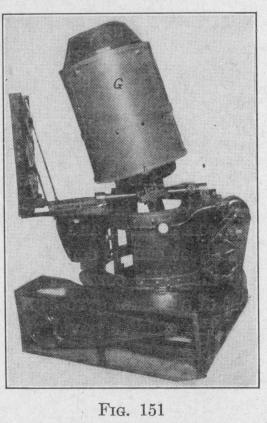196 NAVIGATIONAL COMPASSES
gyro-wheel and the center of gravity of the pendulous mass is vertical; (c) if the point of application of the force on the gyro due to the pendulous mass were shifted back and forth from one side of the vertical to the other in such a manner that a vertical precession is thereby produced which is equal and opposite to that due to the rolling or pitching of the ship; (d) if the natural period of oscillation of the pendulous system were much greater than the period of oscillation of the ship; (e) if the sensitive element were non-pendulous.
118. The Degree of Precision of Gyro-Compasses. - In order that a compass may furnish a satisfactory base line for gun-fire control, it must have a greater degree of precision than is required of a compass used only for navigating the ship. Large naval vessels are equipped with gyro-compasses of the most careful design and workmanship known to the art. Such compasses are called " gun-fire control " compasses. The less severe requirements of merchant vessels and naval vessels of the smaller sizes are met adequately by instruments of a somewhat simpler type called " navigational compasses." Of the gyro-compasses mentioned in the following Articles, the Arma Mark IV and the Sperry Mark X instruments are " gun-fire control " compasses. The others are " navigational " compasses.
The tests of gyro-compasses submitted for use in the United States Navy include measurements of the undamped period and the damping percentage of the sensitive element, the change of settling point when the voltage impressed on the gyro-motors changes, and the change of settling point when the binnacle is rotated about a vertical axis or when rocked about various horizontal axes. The tests of the changes of the settling point produced by rotation and rocking of the binnacle are made by means of a machine called a " scoresby," from the name of the inventor. This machine consists of a platform that can be rotated in either direction about a vertical axis and that can be rocked with a given period and with a given amplitude about a horizontal axis in any azimuth. Figure 151 represents a scoresby rocking a gyro-compass G as in an actual test.
If x and y represent two successive amplitudes of swing in the
same direction, then x x y may be called the fractional damping and 100 \x x I
would be called the damping percentage. The
NATURAL ERRORS 19,
damping percentage is calculated from the amplitudes of the first three peaks as follows - divide one hundred times the amplitude of the second peak by the amplitude of the first peak and subtract the quotient from one hundred; divide one hundred times the amplitude of the third peak by the amplitude of the second peak and subtract the quotient from one hundred. The mean of these two results is the mean percentage of damping. If the
compass be precessed either toward the east or toward the west 30 degrees from the settling point and then released, the damping percentage must not be less than 60 per cent nor more than 80 per cent.
When rotated about a vertical axis at a uniform rate of 3 degrees per second, a gyro-compass of the " navigational " grade must not show an error greater than 0.5 degree during a run of twenty hours, and a gyro-compass of the " gunfire control " grade must not show an error greater than 0.2 degree.
When rocked back and forth
about a horizontal axis through an angle of 15 degrees from the vertical
with a period of 9 seconds a gyro-compass of the " navigational " grade must not show an error greater than 0.6 degree during a run of forty-eight hours, whatever may be the heading, and a gyro-compass of the " gun-fire control " grade must not show an error greater than 0.3 degree.
When rocked back and forth about a horizontal axis through an angle of 40 degrees from the vertical with a period of 9 seconds a gyro-compass of the " navigational " grade must not show an error greater than 1.0 degree during a run of forty-eight hours, whatever may be the heading, and a gyro-compass of the " gunfire control " grade must not show an error greater than 0.5 degree.
When the voltage impressed on the gyro-motor (or motors) is changed from normal to 10 per cent more or less than normal, the maximum settling point error of a gyro-compass of the " navigational " grade must not exceed 0.5 degree, and for a gyro-compass
